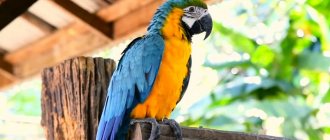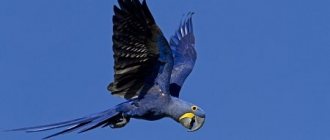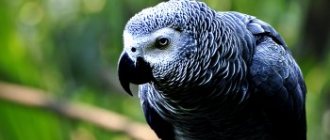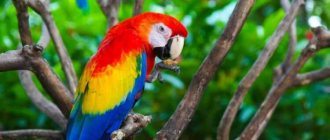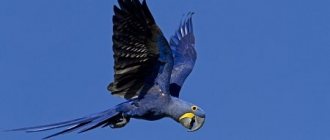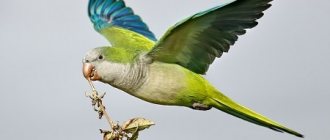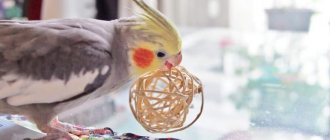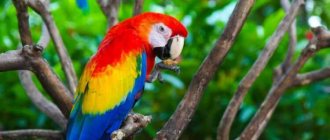Despite their ostentatious external power and grace, parrots are rather fragile creatures.
This fact has already been mentioned several times in our articles and will be mentioned many times so that every inexperienced bird breeder remembers it for the rest of his life.
Not long ago we told you about the possible consequences of broken wings in parrots, and now it’s time to talk about a problem that occurs no less often - broken legs.
Let's try to figure out what to do in such a situation.
We are confident that this article will be useful not only for beginners, but also for experienced bird lovers.
- Cause of a broken leg in a parrot
- Symptoms of a broken leg in a parrot
- Broken leg in a parrot: what to do?
Causes of injuries in parrots
The most common pathologies in parrots are dislocations of the joints of the toes, bruises of the head, neck, torso and wings, wounds, fractures of the tubular bones of the legs (less commonly, the wings).
The following factors can lead to injury:
- Most often, parrots that live outside the cage around the clock or only spend the night in it are injured.
- Birds can injure each other when kept in large groups.
- If the bird is kept indoors with other animals (cats and dogs), there is a danger of mechanical damage and the appearance of bite wounds.
- If a bird likes to sit on the upper edge of open interior doors, it may, without being noticed, get fractures of the tubular bones of its legs when they close.
- Budgerigars injure their limbs by getting their claws stuck in window curtains, in the clothes of their owners, etc. Clumsy, inept or sudden release of the bird can cause dislocation or subluxation of the toe joints.
- If a bird falls into the hands of a small child who cannot yet control the force of compression, the parrot may die from stress or from suffocation.
- Sometimes children pull out live flight or tail feathers from a bird, which also results in bleeding, which can be fatal.
- Large parrots (amazons, cockatoos, grays, some cockatiels, macaws and others) often fiddle with objects that are not intended for this (cosmetic mirrors, hooks, boxes, shoes, etc.), resulting in bruises, hematomas, and wounds. The latter are very dangerous, since in birds, when large vessels rupture, prolonged bleeding occurs, although their blood clotting rate is higher than in mammals.
- When keeping a parrot “on free grazing”, i.e. Without a cage, many objects in the house are dangerous for the bird. The cause of bruises is often uncurtained windows and furniture with mirror surfaces. In case of bruises on glass, fractures of the wings, neck, beak, and less often the body are possible. Fractures most often occur during the molting period of parrots due to a decrease in calcium in the tubular bones. Sadly, severe bruises and fractures often lead to the death of birds.
First aid for a closed fracture
If your parrot breaks its leg, and you do not have the opportunity to deliver the bird to the clinic, then you need to provide your pet with competent medical care.
- To begin with, you should limit the movements of the bird; the less it moves, the better. Therefore, lower the perch, feeder, and drinking bowl to the very bottom of the cage. If you have several perches, you should only leave one.
- Since metabolic processes in these pets occur very quickly, you need to take all measures as soon as possible so that the paw begins to grow together correctly. A slowdown that lasts 2 or 3 days can already have dire consequences for the bird. The main ones are crooked fusion, gangrene, the consequence of which can even be amputation of the paw.
- Be sure to properly and firmly immobilize the broken limb. For this, it is best to use cardboard tires. When fixing the limbs, you need to be extremely careful, since you need to prevent the bones of the paw from moving and moving even in the slightest way. But you shouldn’t fix the fracture too tightly, because this can lead to necrosis or gangrene. Blood should circulate normally in the injured paw.
- Most experts recommend immediately fixing the fracture using a bandage with Levomekol ointment. This remedy will relieve swelling and prepare the bird for the upcoming operation.
- Also, in severe cases, you should use antibiotics, such as: Amoxicillin, Lincomycin, as well as Enrofloxacin and others. But they should be prescribed by an ornithologist, who will also determine the dosage and the necessary scheme for its use.
Signs of injury to a parrot
You can tell if your pet is injured by the following signs:
- the parrot loses its balance;
- one wing is lower than the other;
- the bird does not hold its head up and falls on its side;
- the paw is in an unnatural position, the parrot is limping or tightens its limb when walking;
- Blood is visible at the site of injury, swelling, redness or blueness is observed.
If you notice at least one of the listed symptoms, you must provide first aid as quickly as possible and be sure to show the bird to a veterinarian.
The bird presses its paw
When a parrot tucks one leg, it is probably resting. It is difficult for birds to constantly move, stand and sit with support on two limbs, so they relieve them one by one from the load. But this can only be said with confidence about those birds that always behave this way.
Changed habits may indicate that the parrot is experiencing discomfort. If he is used to sleeping sitting on both legs, but now pulls one of them under himself, he may be in pain. Sometimes discomfort is caused by improperly sized perches. Remove the thin plastic bars from the cage and secure natural, untreated branches in it. Inspect and feel the limb being protected. If you notice a wound, swelling, growths or ulcers, take your bird to the veterinarian.
First aid for an injured bird
If your parrot is bleeding, it must be stopped immediately. As a hemostatic agent when providing first aid to a bird, you can use a tampon moistened with a 3% solution of hydrogen peroxide (or simply squeezing the bleeding site with a tampon), cauterizing the bleeding surface with a crystal or concentrated solution of potassium permanganate. And, naturally, the injured bird needs to be shown to a doctor. At a veterinary clinic, the parrot undergoes a clinical examination, undergoes surgical treatment of its wounds, and undergoes therapeutic measures to stop the bleeding.
An open fracture is not difficult to identify. It is characterized by bleeding, a wound in which fragments of bones are visible. First of all, you need to stop the bleeding, apply a tampon with antiseptic ointment and also carefully bandage the limb to the body. Then you should seek help from a specialist as soon as possible.
Fractures that preserve the integrity of the outer integument are called closed (simple). to determine a simple fracture through a thorough examination of the bird. The injured area may not swell (unlike a sprain), but redness or blueness will be noticeable. In the event of a fracture, it is difficult to bring the wing or leg to its original position - they do not bend. Therefore, a splint must be applied to the injured limb.
With abrasions, bruises and sprains, swelling, redness or blue discoloration of the damaged area is observed. The parrot presses its paw and does not lean on it. Apply trauma gel to the sore spot. It acts as an analgesic, reduces swelling, and has hemostatic and antiseptic properties. Inexperienced bird owners often confuse a fracture with a regular bruise. If the parrot simply hurt its leg, there is no need to apply a splint.
If is dislocated , the leg or wing is bent at an unnatural angle, and the injured area may become slightly blue and swollen. The limb should be carefully returned to the desired position and secured with a bandage, taping (not tightly) the limb to the body.
After injuries, during the recovery period, instead of drinking water, the bird is given honey water and multivitamins. Pollen is used as a natural source of microelements and biologically active substances - 1-2 tablets per 100 g of bird body weight per day.
How to distinguish a dislocation from a fracture
At first glance, a dislocation and a fracture are difficult to distinguish. But it is knowledge of the type of injury that determines the order of your actions to treat your parrot. At its core, a fracture is a violation of the integrity of the bones, and a dislocation is damage to the joint. There are also more complex injuries - combined injuries. For example, bone damage of an intra-articular nature, which does not allow a quick examination at first glance.
Did you know? In Australia there are real educational institutions for parrots. There these birds are taught to speak English.
Behavior of a parrot during a fracture
If a feathered pet breaks its leg, it will begin to behave unconventionally.
Among the unusual actions of the parrot are:
- attempts to hide the injured limb under him when he is sitting;
- after receiving an injury, first be overexcited and active, then suddenly change your mood and become lethargic;
- lameness and trying to minimize use of the injured paw.
If you observe this type of behavior in your bird, you need to have it examined immediately.
Parrot safety
First, it is the parrot owner's job to ensure the safety of the parrot in its cage. The cage should not be cramped. The distance between the rods should be such that the parrot cannot stick its head between them. Sometimes the birds panic, and then they begin to fight in the cage. This could cause injury to your pet, so make sure there are no sharp objects or edges inside the cage.
In order for your bird to have a full life, it is recommended to let it out of its cage to fly. The owner’s task is to eliminate possible dangers. The curtains, at least on the first flights, should be moved. Glass doors and mirrors need to be curtained, otherwise the parrot may fly into them with all its might. Tall vases need to be covered - the bird may slip inside and get hurt.
Remember that while your bird is walking freely, you should not make sudden movements, scream loudly, shake the blankets, etc. – the parrot, frightened, will begin to rush about, and this can lead to injury.
Be careful and careful, take care of your bird!
Share with your friends:
Treatment of fractures
Treatment of fractures in birds consists of immobilizing the injured area using available materials and an adhesive plaster. For small birds, one bandage or plaster is enough, with the help of which the damaged limb is tied to the body. For large birds, immobilization alone is not enough. Surgery is often necessary to fix broken bones using metal pins and pins or plates.
Depending on the severity of the fracture, treatment can last from two weeks to two months. During this time, the sick bird should be placed in a small cage without perches, limiting its freedom of movement. At first she may express her anxiety by trying to fly or stand on her feet, but she will get used to it over time. The diet should be as balanced as possible, enriched with vitamins and microelements, especially calcium.
After removing the bandage fixing the fracture, there is no need to rush to release the bird into its familiar environment. Let her stay in a small cage for some time until she finally gets stronger. Wild birds may no longer fly after a wing fracture; in this case, it is necessary to take care of their future fate in captivity. Once released, they quickly die from the paws of animals.
How to splint a parrot?
Any owner hopes that he will not have to practice these skills on his feathered pet. But it will not be superfluous to know how to help a cockatiel during fractures and bruises. The bird’s recovery, and its life, will not depend on this.
In case of an open fracture, the wound is treated with special creams and ointments. It is best to take your feathered pet to a veterinarian, who will numb the wound, disinfect it and stop the bleeding. During a closed fracture, you need to act a little differently. Professionals recommend feeding the bird a little and only then applying a splint.
Stress is relieved with sweet water. To do this, stir sugar in warm water and give this liquid to the cockatiel using a pipette. Sometimes, due to panic, pet parrots break free and do not allow their wing to be bandaged. In this case, you should take an ordinary sock and make a hole in it for the damaged wing. The bird is placed in this piece of clothing, now it will not be able to flap its second wing and escape. The main thing is not to aggravate the situation during these manipulations.
Experienced breeders always keep a bird first aid kit on hand, which contains all the necessary medications for splinting: small scissors, painkillers and disinfectants, bandages, adhesive tape, cardboard, cloth and ointments. If you do nothing, the wings and paws will grow together on their own, but distortions are possible that will interfere with the feathered pet.
During the operation, it is better that there is no one in the room except the owner. The fracture site is treated with ointment, and unnecessary feathers are removed if necessary. Cardboard is placed near the limb and tied with gauze or bandage. The bandage should be tight and secure. For sprains and ordinary bruises, there is no need to apply a splint. The healing process will speed up if there is always clean water and food with vitamins on the floor.
Correct application of the splint
Fractures can be closed - when the bone does not come out, and open - when it sticks out, breaking the skin. In the first case, the splint is applied to one side of the wing. And in the second, a splint is applied to both sides, and the wound is pre-treated with hydrogen peroxide, and feather fragments are removed from it. Connect the bone anatomically correctly and treat the damaged area with antiseptic ointment using a sterile cotton swab. The splint should clearly fix the bone at the fracture site.
Another tip: it is better to secure the splint before applying it using adhesive tape. If this is not done, then the tire, for which cardboard is most often used, will become damp and the parrot will easily get rid of it. And this will interfere with the process of proper fusion.
Wings play a big role in the life of birds. They not only allow you to fly, but also help you maintain balance when sitting on a perch or perch. You need to remember this and, when applying the splint, give some freedom for balancing. If you have already encountered broken wings in birds, you have noticed that after a fracture fixed by a splint, they do not maintain balance and fall to the side. It's not scary, after time they will learn to cope with it.
The parrot broke its wing - what to do?
Our feathered friends parrots experience great suffering when their wing is broken. Such injury poses a great danger to the bird. Plus there is also a psychological moment, because with a broken wing she feels very defenseless and experiences stress from the inability to avoid a threat to her life. A feathered pet is unable to take off if its wing joint is knocked out, there is a fracture, or a nerve is severely damaged. It is impossible to watch the bird suffer, and the owners are very interested in what to do if the parrot breaks its wing.
Growths, peeling
Every parrot develops tumors on its legs at least once in its life. Ugly growths are a consequence of processes in the skin caused by the activity of parasites. A common infectious disease among birds is knemidocoptic mange, a scabies mite.
Microorganisms colonize unfeathered areas of the skin, make passages in them, feed on particles of the epithelium and secrete their waste products inside. Moving in the skin, the scabies mite causes unbearable itching; the bird constantly itches and pecks at the metatarsus. The skin becomes loose, peels, and the surface layer crumbles.
Growths on the paws
Treatment for scabies is simple, but long-term. The affected paws of the parrot are treated with aversectin ointment according to a special scheme. Unfortunately, recovery does not guarantee that the parrot will not contract the disease again in the future. Ticks are carried on tree branches and used equipment. You can become infected from other birds if quarantine is not observed.
On a note! Growths on the paws appear not only with knemidocoptosis. Excess calcium causes calcareous deposits on the metatarsals in the form of plates. You can cope with this problem by adjusting your diet.
